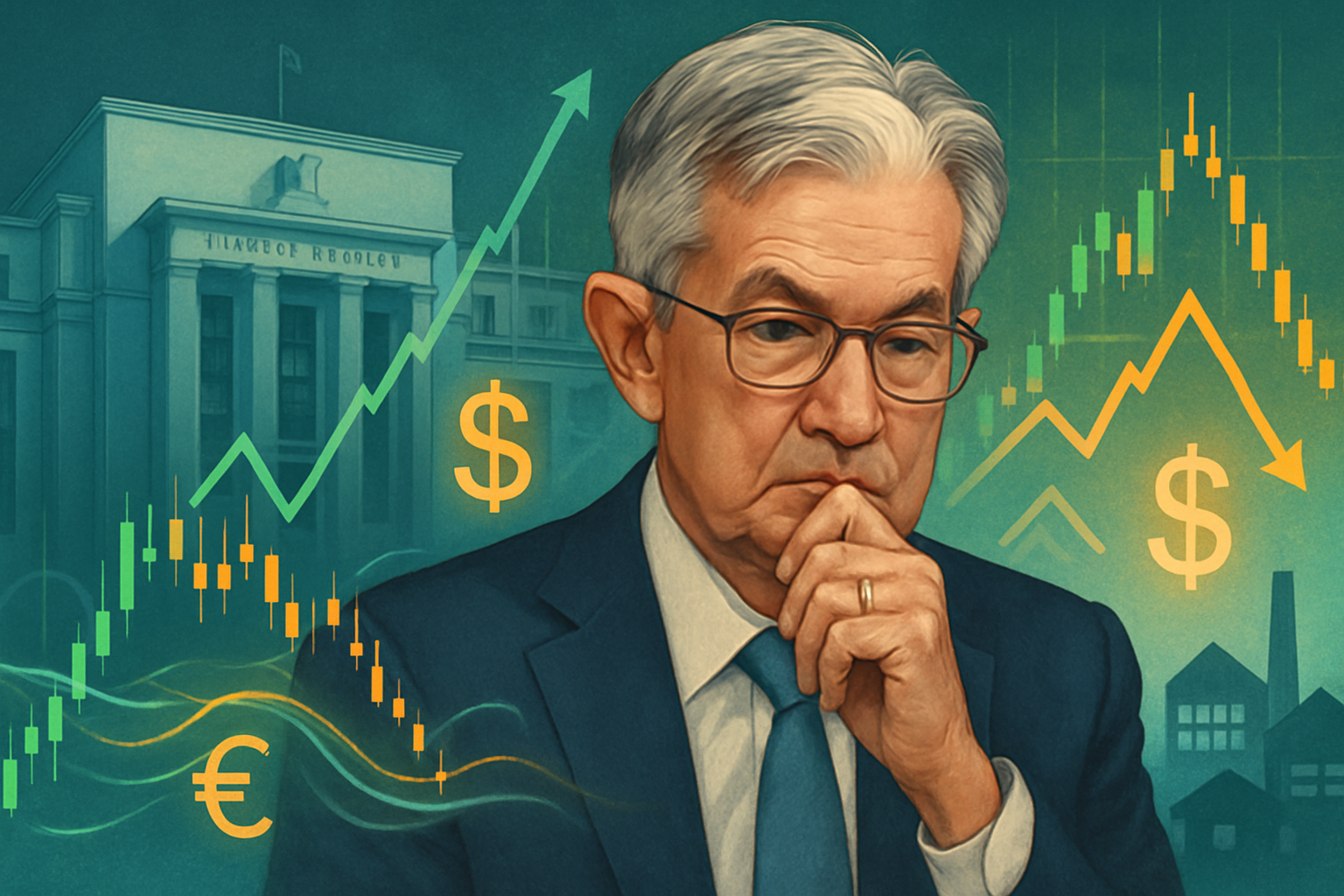
Philadelphia, PA – October 14, 2025 – Federal Reserve Chair Jerome Powell delivered a highly anticipated speech today at the National Association for Business Economics (NABE) conference, signaling that the central bank's program of quantitative tightening (QT) may be "coming into view" for its conclusion. These remarks, interpreted by many as a dovish pivot, immediately sent a ripple of optimism across financial markets, suggesting that a significant phase of monetary policy tightening could soon be behind us.
Powell's comments provided much-needed clarity on the future trajectory of the Fed's balance sheet reduction, which has been a key factor influencing market liquidity and interest rates. Investors quickly reacted to the prospect of eased financial conditions, with equity markets paring earlier losses and bond yields declining, reflecting a collective anticipation of continued accommodative monetary policy and a more favorable environment for risk assets.
The Fed's Shifting Stance: A Detailed Look at Powell's Remarks and Market Response
During his address at the NABE conference, Federal Reserve Chair Jerome Powell articulated a nuanced but clear message regarding the future of quantitative tightening. He stated that the conclusion of the balance sheet reduction program "may be coming into view" and that the Fed "may approach that point in coming months." Powell reiterated the central bank's long-held commitment to halting the runoff once reserves are "somewhat above the level we judge consistent with ample reserve conditions," a critical threshold for maintaining financial stability. He pointed to "emerging signs of gradually tightening liquidity conditions in financial markets," noting "a general firming of repo rates along with more noticeable but temporary pressures on selected dates" as factors informing the Fed's cautious, data-driven approach. Currently, the Fed is reducing its balance sheet by a modest $40 billion monthly, comprising $5 billion in Treasuries and $35 billion in mortgage-backed securities (MBS).
The timeline leading up to this moment has seen the Federal Reserve systematically shrinking its balance sheet since it began QT in June 2022, following an unprecedented expansion during the pandemic to support the economy. This process has gradually removed liquidity from the financial system, aiming to curb inflation alongside interest rate hikes. Key players involved in this policy shift include Chair Powell, the broader Federal Open Market Committee (FOMC) members who vote on monetary policy, and market participants who actively trade based on the Fed's guidance.
Initial market reactions to Powell's statements on October 14, 2025, were swift and largely positive. U.S. equity markets, including the S&P 500 (SPX), rebounded from earlier dips, reflecting investor relief and optimism. In the bond market, U.S. Treasury yields slipped, with the benchmark 10-year note yield falling to 4.04% and the two-year note yield decreasing to 3.495%, indicating expectations of lower future interest rates and increased demand for fixed-income assets. The U.S. dollar index weakened, while gold prices hovered near all-time highs, underscoring its appeal as a safe-haven asset and inflation hedge. Crucially, futures markets signaled a heightened probability of further interest rate cuts, with some reports suggesting a 97% chance of another reduction by the upcoming October 28-29 FOMC meeting, highlighting the market's dovish interpretation of Powell's forward guidance.
Winners and Losers: How the End of QT Could Reshape Corporate Fortunes
The potential cessation of quantitative tightening marks a significant shift in monetary policy, poised to create a distinct landscape of winners and losers across various sectors of the public market. This move typically ushers in an era of more accommodative financial conditions, characterized by potentially lower interest rates and increased market liquidity, which historically favors certain types of businesses over others.
Companies operating in high-growth sectors, particularly technology, stand to be major beneficiaries. These firms often rely heavily on debt financing to fuel their expansion, research, and development initiatives. Lower interest rates translate directly into reduced borrowing costs, thereby enhancing their profitability and making future earnings streams, which are discounted at a lower rate, appear more attractive to investors. The increased liquidity in capital markets also facilitates easier and cheaper access to capital for these companies. For instance, high-growth software-as-a-service (SaaS) providers or innovative biotechnology firms, which prioritize expansion over immediate profits, could see their growth trajectories accelerate. Similarly, a technology giant like Nvidia (NASDAQ: NVDA), if still heavily investing in R&D, could find capital more accessible and affordable.
The real estate and home construction industries are also poised for a significant uplift. These sectors are acutely sensitive to interest rate fluctuations, as rates directly influence mortgage costs for consumers and financing for commercial developments. A lower-rate environment stimulates housing demand by making mortgages more affordable, leading to increased home sales and construction activity. Companies such as homebuilders PulteGroup (NYSE: PHM), D.R. Horton (NYSE: DHI), and Lennar (NYSE: LEN) would likely experience a surge in demand. This positive ripple effect would extend to construction equipment manufacturers like Caterpillar (NYSE: CAT) and building material suppliers such as Builders FirstSource (NYSE: BLDR) and Mohawk Industries (NYSE: MHK). Additionally, highly leveraged companies across various sectors, especially those with significant floating-rate debt, will see their interest expenses diminish, directly boosting their bottom lines and improving cash flow.
Conversely, certain sectors may face headwinds or see their relative appeal diminish. Financial institutions, particularly large commercial banks like JPMorgan Chase (NYSE: JPM) and Bank of America (NYSE: BAC), could experience pressure on their net interest margins (NIM) as interest rates decline. While increased loan volumes and diversified income streams might mitigate some of these effects, a sustained low-rate environment can compress the profitability derived from traditional lending. Similarly, utility companies and other dividend-paying stocks, often favored for their stable income during periods of high interest rates or economic uncertainty, might lose some of their shine. As interest rates fall, the yield spread over risk-free assets narrows, making their dividends less attractive compared to potentially higher returns in growth-oriented investments. Furthermore, defensive sectors like consumer staples, represented by companies such as Procter & Gamble (NYSE: PG) and Coca-Cola (NYSE: KO), while stable, might underperform compared to the more cyclical and rate-sensitive industries that thrive in an expanding economy. The potential conclusion of QT, therefore, marks a pivotal moment, shifting market favor towards growth and cyclical sectors while posing challenges for those reliant on higher interest rate differentials or defensive positioning.
A Broader Perspective: Unpacking the Wider Significance of the Fed's Pivot
The Federal Reserve's contemplation of ending quantitative tightening (QT) in October 2025 transcends immediate market reactions, signaling a profound shift in global monetary policy with far-reaching implications for industry trends, competitive landscapes, regulatory frameworks, and drawing critical lessons from historical precedents. This move occurs as the global economy navigates a delicate transition from aggressive tightening to a more accommodative stance, epitomized by the Fed's ongoing interest rate cutting cycle initiated in late 2024.
This easing cycle is fostering a palpable "risk-on" sentiment across financial markets, propelling investors towards equities and growth assets, with major indices reaching new highs. Despite this optimism, lingering jitters persist, exacerbated by uncertainties such as an ongoing U.S. government shutdown, which has created a "data blackout" and complicated policy decisions with incomplete information. Meanwhile, the relentless artificial intelligence (AI) boom continues to be a significant economic driver, attracting robust investment, particularly in high cash flow-generating tech companies. The cessation of QT will likely amplify these trends, further encouraging investment in growth-oriented sectors and potentially accelerating technological innovation.
The ripple effects of this policy shift are expected to be substantial. Companies with high leverage, across various industries, stand to gain a competitive advantage due as financing costs decrease. Conversely, businesses with large cash reserves might see diminished returns on their assets, subtly altering their financial strategies. Globally, the Federal Reserve's actions wield immense influence, impacting international capital flows, currency exchange rates, and often guiding the policy decisions of other central banks worldwide. While easing policies stimulate growth, they also carry the inherent risk of fostering financial vulnerabilities, including excess credit and compressed risk premiums. A severe correction in the U.S. market, potentially triggered by unsustainable fiscal policies or speculative investments in areas like AI, could precipitate a global de-risking event, impacting international markets and investment flows, and potentially leading to significant losses for foreign banks, institutional investors, and sovereign wealth funds with exposure to U.S. equities.
From a regulatory and policy standpoint, central banks face a delicate balancing act. The Fed's objective is to cease balance sheet runoff when reserves are "somewhat above the level we judge consistent with ample reserve conditions" to prevent a recurrence of past money market strains. However, internal debate continues regarding the optimal level of reserves. Regulatory adjustments are also in play, with the Federal Reserve proposing significant changes to the enhanced Supplementary Leverage Ratio (eSLR) in June 2025. This reform aims to loosen a key capital constraint for large banks, potentially unlocking billions in capital, improving treasury market liquidity, and reshaping bank balance sheets. Historically, the unwinding of large central bank balance sheets, often following crises, has been a long and gradual process, characterized more by holding nominal positions stable relative to output rather than aggressive nominal reductions. The "repo ruckus" of September 2019, where overnight lending rates spiked due to reserve scarcity, serves as a crucial historical lesson, underscoring the Fed's current "deliberately cautious approach" to avoid similar money market strains. Central banks are also exploring "business-as-usual" asset purchases post-QT to offset the growth of currency in circulation, emphasizing these are not new rounds of quantitative easing, but rather a mechanism to maintain an appropriate level of reserves.
The Road Ahead: Navigating the Post-QT Landscape
The anticipated conclusion of quantitative tightening (QT) heralds a new phase for financial markets and corporate strategy, presenting both significant opportunities and formidable challenges in the short and long term. As of October 2025, the market is poised to adapt to a more liquid and potentially lower-interest-rate environment, necessitating strategic pivots from businesses and offering new avenues for investors.
In the short term, the immediate aftermath of QT's end is likely to reinforce the "risk-on" sentiment already prevalent in markets. Equity markets could see continued upward momentum, particularly for growth stocks and those in rate-sensitive sectors. Companies will find borrowing cheaper, potentially spurring increased capital expenditure, mergers and acquisitions, and share buybacks. However, the market will closely scrutinize the Fed's communication regarding its balance sheet strategy post-QT, including any "business-as-usual" asset purchases to manage liquidity, to ensure this isn't misinterpreted as a return to full-blown quantitative easing. Lingering uncertainties, such as the U.S. government shutdown and its impact on economic data, will remain a key watchpoint, potentially introducing volatility even amidst a generally dovish Fed stance.
Looking further ahead, the long-term implications are more complex. While increased liquidity and lower rates generally support economic growth, the Fed's ability to respond to future economic downturns could be constrained if its balance sheet remains elevated. Companies will need to strategically adapt to this new environment. Highly leveraged firms will need to optimize their debt structures, potentially refinancing at lower rates to improve profitability. Financial institutions, while facing potential net interest margin compression, might pivot towards fee-based services or diversified revenue streams to maintain profitability. Technology companies, benefiting from cheaper capital, could accelerate innovation and expansion, potentially leading to increased competition and disruption across various industries.
Emerging market opportunities are likely to arise in sectors that thrive on accessible capital and consumer spending, such as renewable energy, infrastructure development, and advanced manufacturing. Challenges, however, include the potential for asset bubbles if liquidity becomes excessive, and the risk of a "liquidity trap" where monetary policy becomes less effective in stimulating demand. Potential scenarios range from a "soft landing" where the economy achieves stable growth with moderate inflation, to a more challenging environment if unforeseen shocks occur, or if the Fed misjudges the "ample" level of reserves, leading to renewed money market strains. Investors should brace for a period of ongoing recalibration, where the market seeks to understand the new equilibrium of monetary policy and its broader economic impact.
Conclusion: A New Chapter in Monetary Policy and Market Dynamics
Federal Reserve Chair Jerome Powell's recent comments on October 14, 2025, signaling the potential conclusion of quantitative tightening (QT), mark a pivotal moment in monetary policy, drawing to a close an era of balance sheet reduction and ushering in a new phase of financial market dynamics. The key takeaway is clear: the central bank is moving towards a more accommodative stance, aiming to ensure ample liquidity in the financial system while supporting economic growth. This shift, largely interpreted as dovish, has already ignited optimism across equity markets, led to falling bond yields, and heightened expectations for further interest rate cuts.
Moving forward, the market is poised for a recalibration. The end of QT is expected to foster a "risk-on" environment, benefiting growth-oriented sectors, highly leveraged companies, and real estate, as cheaper capital and increased liquidity fuel investment and consumer spending. Conversely, financial institutions might face pressure on net interest margins, and traditionally defensive sectors could see their relative appeal diminish. The wider significance of this pivot extends to global capital flows, potential regulatory adjustments like the eSLR reforms, and the ongoing challenge for central banks to maintain financial stability without inadvertently creating new vulnerabilities. The historical context of previous balance sheet unwinds and lessons from past liquidity events, such as the 2019 repo market strains, underscore the Fed's cautious and data-driven approach.
The lasting impact of this policy shift could be profound, potentially laying the groundwork for sustained economic expansion, albeit with the inherent risks of asset bubbles if not managed judiciously. It also re-establishes interest rates as the primary tool for monetary policy, providing the Fed with "dry powder" for future economic interventions. For investors, the coming months will demand vigilance. Key areas to watch include the Fed's explicit communication on the exact timing and parameters for ending QT, any further details on its post-QT balance sheet strategy, and the evolution of economic data, particularly inflation and employment figures. The response of other global central banks and the trajectory of geopolitical events will also be critical in shaping market sentiment. Adapting portfolios to favor sectors poised to benefit from increased liquidity and lower borrowing costs, while carefully monitoring potential risks, will be paramount in navigating this evolving financial landscape.
This content is intended for informational purposes only and is not financial advice







